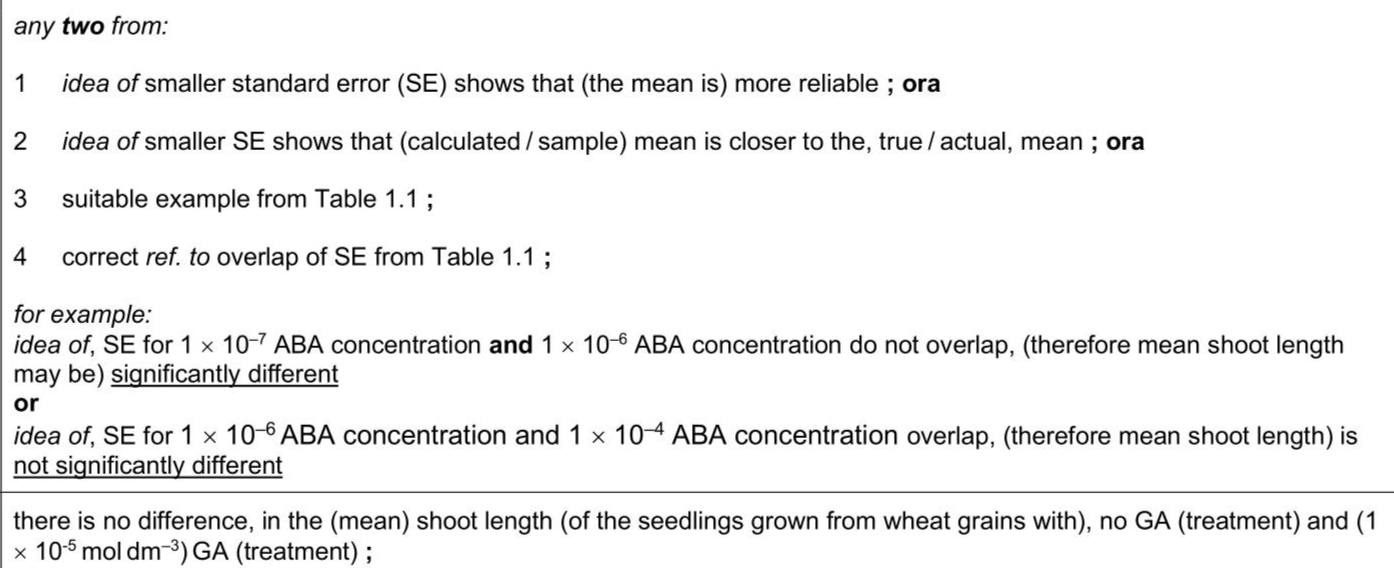A student investigated the effect of gibberellin(GA)and abscisic acid(ABA)on the germination of wheat grains. The student found out the following information. -The molecular mass of GA is 346 g . -The molecular mass of ABA is 264 g . -The range of concentrations at which GA is active in plant tissues is from $$\(1 \times 10^{-6}\)$$ to $$\(1 \times 10^{-5} \mathrm{moldm}^{-3}\)$$ . -The range of concentrations at which ABA is active in plant tissues is from $$\(1 \times 10^{-6}\)$$ to $$\(1 \times 10^{-4} \mathrm{moldm}^{-3}\)$$ . -Newly formed wheat grains contain a high concentration of ABA which decreases over time. -When the concentration of ABA falls low enough the GA is able to promote germination. -Wheat germinates best at temperatures from $$\(10^{\circ} \mathrm{C}\)$$ to $$\(25^{\circ} \mathrm{C}\)$$ and without light. Fig. 1.1 shows the germination and early growth of wheat. To test the effects on germination of adding $$\(A B A\)$$ ,the student started by soaking wheat grains for 24 hours in a solution of $$\(1 \times 10^{-6} \mathrm{~mol}^{-3} \mathrm{GA}\)$$ .These were then split into several groups of 50 grains and a different concentration of ABA was added to each group. The student made a stock solution of ABA with a concentration of $$\(1 \times 10^{-3} \mathrm{~mol} \mathrm{dm}^{-3}\)$$ which was then diluted to make the solutions needed for the investigation. In another investigation the student tested the effect of gibberellin (GA) on the elongation of shoots. Five groups of 20 wheat grains were soaked in GA solution. Each group was treated with a different concentration of GA and then left to germinate and grow for 10 days. The length of each shoot was measured and a mean shoot length was calculated for each GA concentration. Table 1.1 shows the results of this investigation. (i) Explain what standard error (SE) shows about the reliability of the results in Table 1.1. . . . . The student carried out a number of $$\(t\)$$-tests. In each $$\(t\)$$-test, the student compared the mean shoot length of the seedlings grown from grains that were not treated with GA with those that were treated with GA. (ii) Suggest a null hypothesis for the $$\(t\)$$-test between no GA treatment and those treated with $$\(1 \times 10^{-5} \mathrm{~mol} \mathrm{dm}^{-3} \mathrm{GA}\)$$. . . (iii) Explain how the student should use the values for $$\(t\)$$ to determine if there is a significant difference between the mean shoot length of wheat grown with no GA treatment and the mean shoot length of wheat grown with GA treatment. . . . . .
Exam No:9700_s25_qp_54 Year:2025 Question No:1(d)
Answer:


Knowledge points:
15.2.1 describe the rapid response of the Venus fly trap to stimulation of hairs on the lobes of modified leaves and explain how the closure of the trap is achieved
15.2.2 explain the role of auxin in elongation growth by stimulating proton pumping to acidify cell walls
15.2.3 describe the role of gibberellin in the germination of barley (see 16.3.4)
Solution:
Download APP for more features
1. Tons of answers.
2. Smarter Al tools enhance your learning journey.
IOS
Download
Download
Android
Download
Download
Google Play
Download
Download
